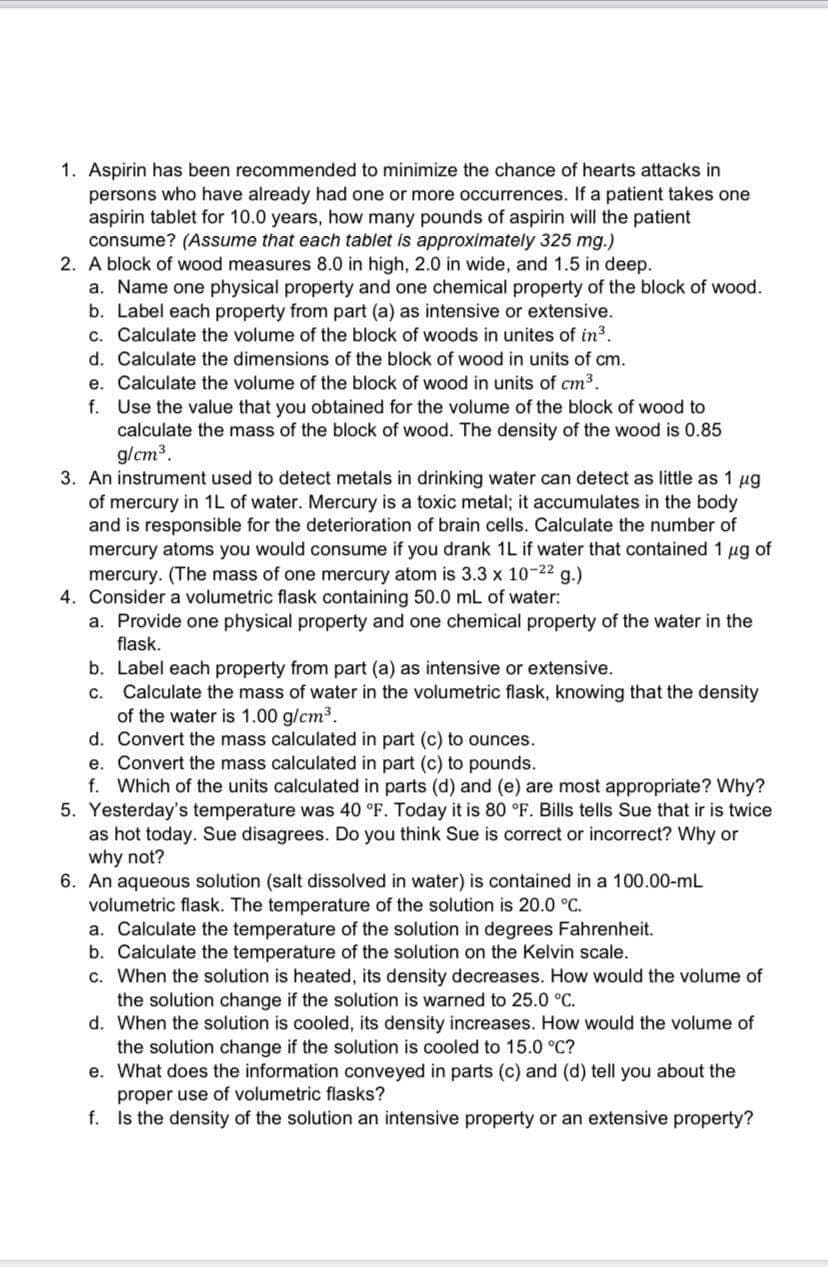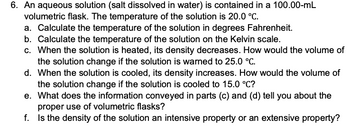1. Aspirin has been recommended to minimize the chance of hearts attacks in persons who have already had one or more occurrences. If a patient takes one aspirin tablet for 10.0 years, how many pounds of aspirin will the patient consume? (Assume that each tablet is approximately 325 mg.)
1. Aspirin has been recommended to minimize the chance of hearts attacks in persons who have already had one or more occurrences. If a patient takes one aspirin tablet for 10.0 years, how many pounds of aspirin will the patient consume? (Assume that each tablet is approximately 325 mg.)
Chemistry by OpenStax (2015-05-04)
1st Edition
ISBN:9781938168390
Author:Klaus Theopold, Richard H Langley, Paul Flowers, William R. Robinson, Mark Blaser
Publisher:Klaus Theopold, Richard H Langley, Paul Flowers, William R. Robinson, Mark Blaser
Chapter1: Essential Ideas
Section: Chapter Questions
Problem 42E: Visit this PhET density simulation (http://openstaxcollege.org/l/16phetmasvolden) and select Custom...
Related questions
Question
100%

Transcribed Image Text:1. Aspirin has been recommended to minimize the chance of hearts attacks in
persons who have already had one or more occurrences. If a patient takes one
aspirin tablet for 10.0 years, how many pounds of aspirin will the patient
consume? (Assume that each tablet is approximately 325 mg.)
2. A block of wood measures 8.0 in high, 2.0 in wide, and 1.5 in deep.
a. Name one physical property and one chemical property of the block of wood.
b. Label each property from part (a) as intensive or extensive.
c. Calculate the volume of the block of woods in unites of in³.
d. Calculate the dimensions of the block of wood in units of cm.
e. Calculate the volume of the block of wood in units of cm³.
f.
Use the value that you obtained for the volume of the block of wood to
calculate the mass of the block of wood. The density of the wood is 0.85
g/cm³.
3. An instrument used to detect metals in drinking water can detect as little as 1 µg
of mercury in 1L of water. Mercury is a toxic metal; it accumulates in the body
and is responsible for the deterioration of brain cells. Calculate the number of
mercury atoms you would consume if you drank 1L if water that contained 1 µg of
mercury. (The mass of one mercury atom is 3.3 x 10-22 g.)
4. Consider a volumetric flask containing 50.0 mL of water:
a. Provide one physical property and one chemical property of the water in the
flask.
b. Label each property from part (a) as intensive or extensive.
c. Calculate the mass of water in the volumetric flask, knowing that the density
of the water is 1.00 g/cm³.
d. Convert the mass calculated in part (c) to ounces.
e. Convert the mass calculated in part (c) to pounds.
f. Which of the units calculated in parts (d) and (e) are most appropriate? Why?
5. Yesterday's temperature was 40 °F. Today it is 80 °F. Bills tells Sue that ir is twice
as hot today. Sue disagrees. Do you think Sue is correct or incorrect? Why or
why not?
6. An aqueous solution (salt dissolved in water) is contained in a 100.00-mL
volumetric flask. The temperature of the solution is 20.0 °C.
a. Calculate the temperature of the solution in degrees Fahrenheit.
b. Calculate the temperature of the solution on the Kelvin scale.
c. When the solution is heated, its density decreases. How would the volume of
the solution change if the solution is warned to 25.0 °C.
d. When the solution is cooled, its density increases. How would the volume of
the solution change if the solution is cooled to 15.0 °C?
e. What does the information conveyed in parts (c) and (d) tell you about the
proper use of volumetric flasks?
f.
Is the density of the solution an intensive property or an extensive property?
Expert Solution
This question has been solved!
Explore an expertly crafted, step-by-step solution for a thorough understanding of key concepts.
This is a popular solution!
Trending now
This is a popular solution!
Step by step
Solved in 2 steps

Follow-up Questions
Read through expert solutions to related follow-up questions below.
Follow-up Question
please answer 6c, 6d, 6e and 6f. Thank you.

Transcribed Image Text:6. An aqueous solution (salt dissolved in water) is contained in a 100.00-mL
volumetric flask. The temperature of the solution is 20.0 °C.
a. Calculate the temperature of the solution in degrees Fahrenheit.
b. Calculate the temperature of the solution on the Kelvin scale.
c. When the solution is heated, its density decreases. How would the volume of
the solution change if the solution is warned to 25.0 °C.
d. When the solution is cooled, its density increases. How would the volume of
the solution change if the solution is cooled to 15.0 °C?
e. What does the information conveyed in parts (c) and (d) tell you about the
proper use of volumetric flasks?
f.
Is the density of the solution an intensive property or an extensive property?
Solution
Knowledge Booster
Learn more about
Need a deep-dive on the concept behind this application? Look no further. Learn more about this topic, chemistry and related others by exploring similar questions and additional content below.Recommended textbooks for you

Chemistry by OpenStax (2015-05-04)
Chemistry
ISBN:
9781938168390
Author:
Klaus Theopold, Richard H Langley, Paul Flowers, William R. Robinson, Mark Blaser
Publisher:
OpenStax

Chemistry: Principles and Reactions
Chemistry
ISBN:
9781305079373
Author:
William L. Masterton, Cecile N. Hurley
Publisher:
Cengage Learning

Introductory Chemistry: An Active Learning Approa…
Chemistry
ISBN:
9781305079250
Author:
Mark S. Cracolice, Ed Peters
Publisher:
Cengage Learning

Chemistry by OpenStax (2015-05-04)
Chemistry
ISBN:
9781938168390
Author:
Klaus Theopold, Richard H Langley, Paul Flowers, William R. Robinson, Mark Blaser
Publisher:
OpenStax

Chemistry: Principles and Reactions
Chemistry
ISBN:
9781305079373
Author:
William L. Masterton, Cecile N. Hurley
Publisher:
Cengage Learning

Introductory Chemistry: An Active Learning Approa…
Chemistry
ISBN:
9781305079250
Author:
Mark S. Cracolice, Ed Peters
Publisher:
Cengage Learning

Introductory Chemistry: A Foundation
Chemistry
ISBN:
9781337399425
Author:
Steven S. Zumdahl, Donald J. DeCoste
Publisher:
Cengage Learning

